
The Metropolitan Atlanta Rapid Transit Authority is the principal public transport operator in the Atlanta metropolitan area. Formed in 1971 as strictly a bus system, MARTA operates a network of bus routes linked to a rapid transit system consisting of 48 miles (77 km) of rail track with 38 train stations. MARTA's rapid transit system is the eighth-largest rapid transit system in the United States by ridership.

The Southeast Corridor (SEC) is a proposed passenger rail transportation project in the Mid-Atlantic and Southeastern United States to extend high-speed passenger rail services from Washington, D.C. south through Richmond, Petersburg with a spur to Norfolk in Virginia through Raleigh, Durham, Greensboro and south to Charlotte in North Carolina and connect with the existing high-speed rail corridor from D.C. to Boston, Massachusetts known as the Northeast Corridor. Since first established in 1992, the U.S. Department of Transportation (USDOT) has extended the corridor to Atlanta, Georgia and Macon, Georgia; Greenville, South Carolina; Columbia, South Carolina; Jacksonville, Florida; and Birmingham, Alabama.

Doraville is a train station in Doraville, Georgia, and the northern terminus on the Gold Line of the Metropolitan Atlanta Rapid Transit Authority (MARTA) rail system. Doraville serves as the ground for the Doraville rail yard for the Gold line, with a capacity of 30 rail cars.
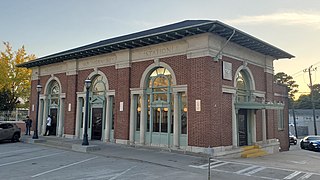
Atlanta Peachtree Station is a train station in Atlanta, Georgia. It is currently a service stop for Amtrak's Crescent passenger train. The street address is 1688 Peachtree Road, Northwest, in the Brookwood section of town between Buckhead and Midtown.
The Metropolitan Atlanta Rapid Transit Authority was created as the first public mass transit agency in metropolitan Atlanta. Its formation in 1965 was a result of the campaigning efforts of governmental planning agencies and Atlanta businessmen. The system broke ground on its rail system in 1975.
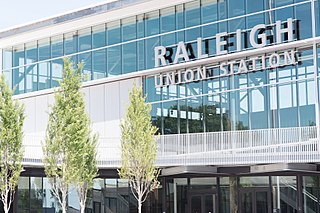
Raleigh Union Station is an intermodal transit station in Raleigh, North Carolina, United States. Train service began the morning of July 10, 2018. Its main building serves as an Amtrak train station, while a future adjacent building will serve as the bus terminus for GoTriangle. The station is located at the Boylan Wye, a railroad junction used by CSX and Norfolk Southern, and adjacent to the Depot Historic District in downtown Raleigh.

The Passaic–Bergen–Hudson Transit Project is a project under study by NJ Transit to reintroduce passenger service on a portion of the New York, Susquehanna and Western Railway (NYSW) right-of-way (ROW) in Passaic, Bergen and Hudson counties using newly built, FRA-compliant diesel multiple unit rail cars. Plans call for service to run from Hawthorne south through Paterson, east to Hackensack and then southeast to North Bergen, where it would join the Hudson-Bergen Light Rail (HBLR).

Charlotte Gateway Station is a future intermodal transit station in Charlotte, North Carolina, United States. Currently operating as a streetcar stop for the CityLynx Gold Line, it is the centerpiece of the overall 19-acre (7.7 ha) Station District, and it will serve Charlotte Area Transit System (CATS) bus lines, the Lynx Silver Line light rail, Amtrak intercity trains and Greyhound Lines intercity buses. The district will also include parking facilities, mixed-use development and an elevated greenway. Estimated at a cost of $800.1 million for full implementation of all public and private components, the project will be built in three phases, with Amtrak service tentatively scheduled to start in 2024.
The transportation system of Georgia is a cooperation of complex systems of infrastructure comprising over 1,200 miles (1,900 km) of interstates and more than 120 airports and airbases serving a regional population of 59,425 people.

The Atlanta Constitution Building, also known as the Georgia Power Atlanta Division Building, is located at the northwest corner of Alabama and Forsyth Streets in downtown Atlanta, Georgia, at 143 Alabama Street, SW. It is located in an area known as the "Heart of Atlanta" straddling the railroad gulch, "due to [its] proximity to the 'Zero Mile Post' which marked both the Southeastern terminus of the Western and Atlantic railroad and the city's earliest settlement". The former Atlanta Constitution Building was designed by Adolph Wittman and was located at the opposite corner of the intersection beginning in 1895.
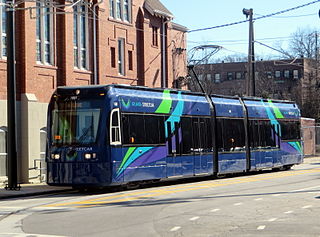
Atlanta Streetcar or Downtown Loop is a streetcar line in Atlanta, Georgia, United States. Testing on the line began in summer 2014 with passenger service beginning as scheduled on December 30, 2014. In 2022, the line had 158,000 rides, or about 300 per weekday in the fourth quarter of 2022.
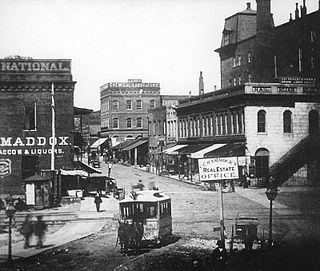
Streetcars originally operated in Atlanta downtown and into the surrounding areas from 1871 until the final line's closure in 1949.
This article is intended to give an overview of transportation in North Carolina.
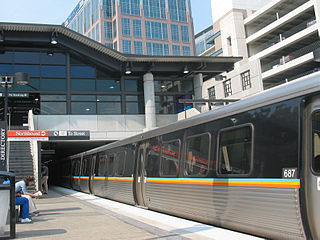
Lindbergh, officially Lindbergh/Morosgo, is a neighborhood in the Buckhead district of Atlanta, Georgia. Most of the neighborhood consists of multi-use development combining retail, office and residential space.
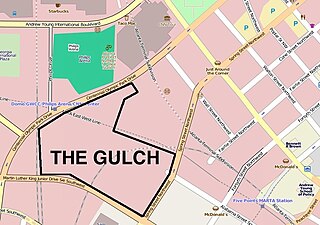
The Gulch is an area of Downtown Atlanta, Georgia, which is unbuilt but envisioned as the site of major development.
The Green Line is a development corridor in Downtown Atlanta stretching from Georgia International Plaza in the west, including The Gulch, and following the rail corridor east alongside Underground Atlanta and terminating at Jesse Hill, Jr. Drive SE The Gulch would be covered with parking and transit underneath and open space on top.
Atlanta's transportation system is a complex infrastructure of several systems, including 47.6 miles of heavy rail, 91 bus transit routes, 1,600 licensed taxis, a comprehensive network of freeways, the world's busiest airport and over 45 miles of bike paths.
Lakewood Terminal is a regional bus terminal owned and operated by NJ Transit (NJT) at 1st & Lexington Avenues in Lakewood, New Jersey. Bus service includes routes to Atlantic City, Hudson County, New York, Philadelphia, and points at the Jersey Shore, including those of the Ocean County bus network, Ocean Ride. It is situated near the intersection of Route 88 and U.S. Route 9, a busy commuter corridor and the former Central Railroad of New Jersey right-of-way, where the MOM rail line may eventually travel. There are 92 parking spaces available at the bus station.
The Downtown Rail Extension (DTX) is a planned second phase of the San Francisco Transbay Transit Center (TTC). When complete, it will extend the Caltrain Peninsula Corridor commuter rail line from its current northern terminus at 4th and King via a 1.3 mi (2.1 km) tunnel. The new terminus will be near the Financial District and will provide intermodal connections to BART, Muni, Transbay AC Transit buses, and long-distance buses. In addition, the California High Speed Rail Authority (CHSRA) plans to use DTX and the Caltrain-owned Peninsula Corridor for service on the CHSRA San Francisco–San Jose segment. Because DTX uses a long tunnel, current diesel locomotives are not suitable and the Caltrain Modernization Project (CalMod), which includes electrification of the line and acquisition of electrified rolling stock, is a prerequisite.
Clayton County commuter rail was a proposed commuter rail line traversing Clayton County, Georgia and connecting with the MARTA rapid transit system at East Point station. It was replaced by a BRT system by the Clayton County Board of Commissioners, the City Councils of Jonesboro, Forest Park, Lovejoy, Riverdale and Lake City, and the Clayton County Chamber of Commerce, MARTA Board of Directors Planning and Capital Programs Committee on Nov. 17, 2022 due to a variety of obstacles with right-of-way acquisition, environmental and historical resource concerns, along with a ballooning cost estimate.












